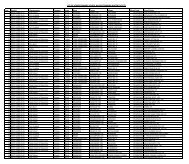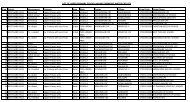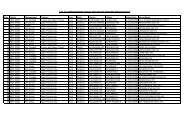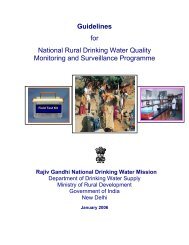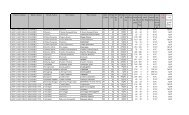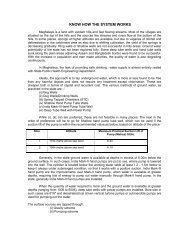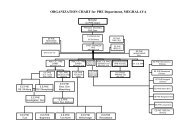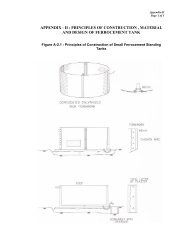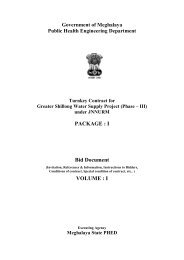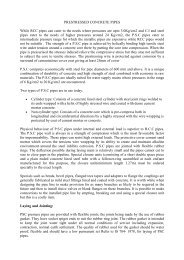PACKAGE : I Bid Document VOLUME : II - Public Health Engineering
PACKAGE : I Bid Document VOLUME : II - Public Health Engineering
PACKAGE : I Bid Document VOLUME : II - Public Health Engineering
Create successful ePaper yourself
Turn your PDF publications into a flip-book with our unique Google optimized e-Paper software.
Education of crew members as to the need for avoiding contamination of the main<br />
during construction is fundamental. Contractors and workmen should be thoroughly<br />
familiar with all pertinent state and local requirements governing installation of mains.<br />
All sewers, water mains and other underground conduits should be located prior to<br />
construction and relocated, if necessary, to prevent contamination during construction.<br />
Pipe should be strung on high ground. At all times when construction is not actually in<br />
progress, watertight plugs should be installed in all pipe openings. Gunny sacks and<br />
rags are not adequate. Provision should be made to pump any other water that might<br />
collect in the trench. Special care should be taken to avoid contamination of valves,<br />
fittings and pipe interiors, both before and during construction each of them should be<br />
inspected and, if necessary, cleaned before installation.<br />
After pressure testing the main, it should be flushed with water of sufficient velocity<br />
to remove all dirt and other foreign materials.<br />
18.13 Communications.<br />
During all phases of cleaning, testing, disinfecting, flushing and commissioning,<br />
reliable communication system between both ends of the section of the pipe line<br />
being dealt with as well as between the field parties in between these sections<br />
should be established.<br />
Removal, restoration and maintenance of paved footpaths, after laying of pipe:<br />
Allowable removal of pavement: Pavement and road surfaces may be removed as a<br />
part of the trench excavation, and the amount removed shall depend upon the width<br />
of trench specified for the installation of the pipe and the width and length of the<br />
pavement area required to be removed for the installation of gate valves, specials,<br />
man-holes or other structures. The width of pavement removed along the normal<br />
trench for the installation of the pipe shall not exceed the width of the trench<br />
specified by more than 150mm on each side of the trench. The width and lengths of<br />
the area of pavement removed for the installation of gate valves, specials, manholes<br />
or other structures shall not exceed the maximum linear dimensions of such<br />
structures by more than 150mm on each side. Wherever, in the opinion of the<br />
authority, existing conditions make it necessary or advisable to remove additional<br />
pavement, it shall be removed as directed by the Engineer-in-charge.<br />
Replacement of pavements and structures :<br />
All pavements paved footpaths, curbing, gutters, shrubbery, fences, poles, sods or<br />
other property and surface structures removed or disturbed as a part of the work<br />
shall be restored to a condition equal to that before the work began, furnishing all<br />
DTS : Detailed Tender Specification. Page 177



